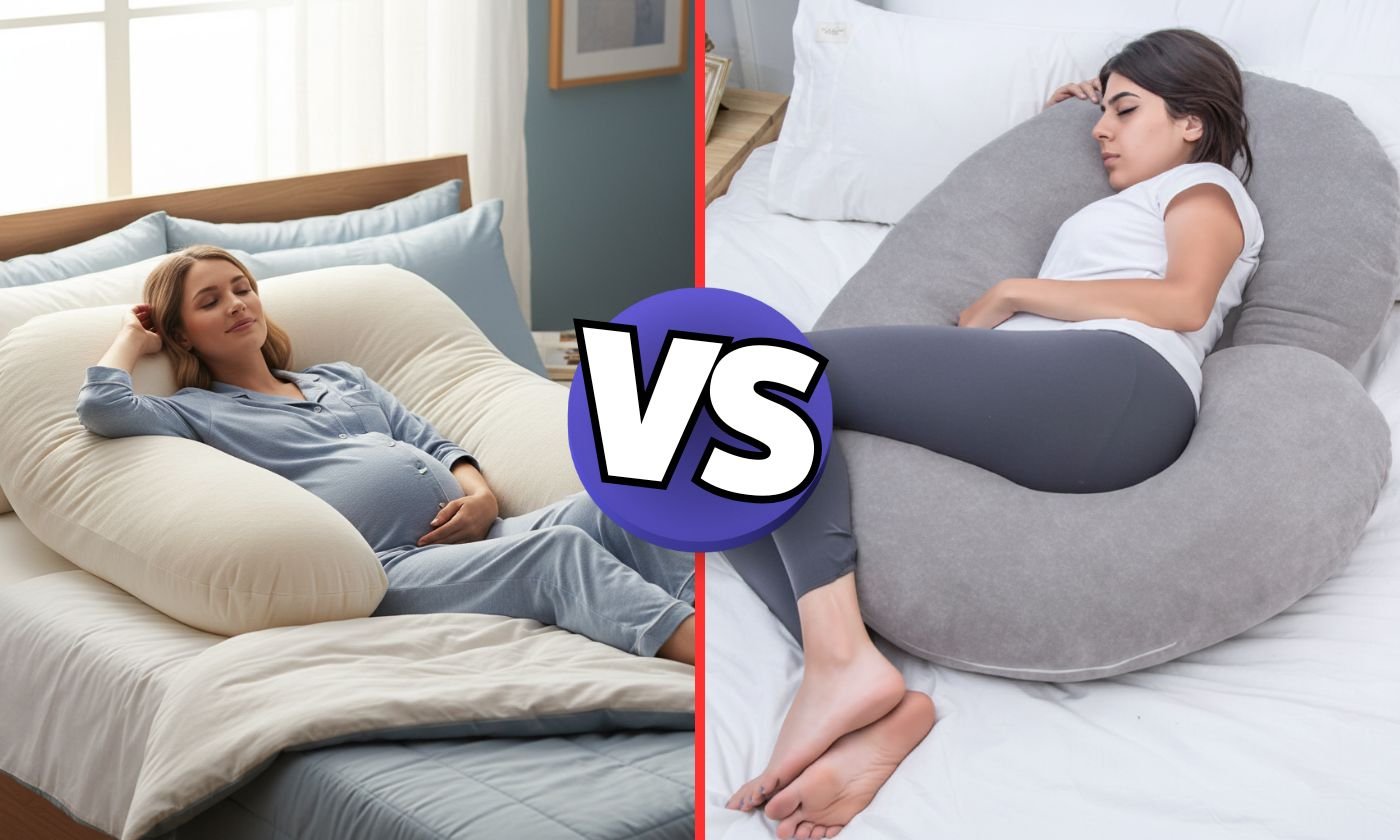
U-Shaped vs C-Shaped Pregnancy Pillow: Which One Helps You Sleep Better?
Growing bump, shifting hips, and restless nights, sound familiar? The right pregnancy pillow can transform your sleep by supporting your back, belly, hips, and knees so your body stays aligned. Two shapes dominate the market: U-shaped and C-shaped. This guide breaks down exactly how they differ, who each one suits best, and how to position them for maximum comfort throughout your trimesters (and beyond).
Quick Answer
-
Pick a U-shaped pregnancy pillow if you switch sides a lot, need simultaneous back + belly support, or want a “hug on both sides.”
-
Pick a C-shaped pregnancy pillow if you want a more compact option that focuses support on the front/hips and is easier to store in small bedrooms.
U-Shaped vs C-Shaped: Side-by-Side Comparison
| Feature / Need | U-Shaped | C-Shaped |
|---|---|---|
| Support coverage | Full-body (head/neck, back + belly, hips, knees) on both sides | Front-focused (head/neck, belly + hips, knees) |
| Side switching at night | Easiest—just roll to the other rail | Needs re-curving/re-positioning |
| Back support while side-sleeping | Excellent | Moderate (requires careful positioning) |
| Bed space needed | Higher (bulkier) | Lower (compact) |
| Typical price | Mid–High | Low–Mid |
| Best for | Restless sleepers, multi-area pain, taller bodies, larger beds | Smaller spaces, targeted belly/hip support, budget |
What a U-Shaped Pregnancy Pillow Does (and Who It’s For)
A U-shaped pillow wraps around both sides of your body like a horseshoe. One “rail” supports your back, the other cradles your belly, while the base sits between your knees to align hips and reduce pressure.
Choose U-shaped if you:
-
Toss and turn or switch sides during the night.
-
Want firm back support to stay comfortably on your side.
-
Struggle with lower back pain, sciatica, pelvic girdle pain, or hip pressure.
-
Share a Queen/King bed and have room for a larger pillow.
-
Want extra versatility postpartum (lounging, nursing, reading).
What a C-Shaped Pregnancy Pillow Does (and Who It’s For)
A C-shaped pillow curves along the front of your body. You rest your head on the top, hug the middle, and place the tail between your knees to align the hips. It’s easier to store and carry from bed to sofa.
Choose C-shaped if you:
-
Have a smaller bed/room and want a space-saving design.
-
Prefer a front hug feeling with strong belly/hip support.
-
Want something lighter that’s easier to move or travel with.
-
Are on a tighter budget and still want targeted relief.
Match the Shape to Your Symptoms
-
Lower back pain / sciatica: U-shaped usually wins thanks to consistent back contact + knee separation.
-
Pelvic girdle pain/hip pain: Both help make sure the tail/base sits between knees so hips stay level.
-
Heartburn/acid reflux: Either shape works; add gentle head elevation.
-
Snoring / airway issues: Both promote side-sleeping; U-shaped can add extra neck alignment options.
-
Round ligament discomfort: Look for belly lift without sagging (either shape with supportive midsection).
How to Position Them (Step-by-Step)
U-Shaped (Side-Sleeping)
-
Rest your head/neck on the curve.
-
Bring one rail in front to support your belly; keep the other behind for back contact.
-
Slide the base between your knees to level hips.
-
To switch sides, just roll, no need to flip the pillow.
Pro tip: Keep ears, shoulders, and hips aligned to avoid twisting.
C-Shaped (Side-Sleeping)
-
Head on the top curve; hug the middle section.
-
Pull the tail between your knees for hip alignment.
-
Tuck a portion of the curve under the belly for gentle lift.
-
For back comfort, angle part of the “C” along your lower back.
-
Switching sides? Re-curve and reposition the pillow to the new side.
Size, Fill, and Fabric: Comfort Specs That Matter
Size & Length
-
U-shaped: Commonly 55–65 in (140–165 cm) end-to-end; better for taller bodies and larger beds.
-
C-shaped: Often 50–60 in (127–152 cm); easier in small bedrooms.
Fill Types
-
Polyfill: Soft, light, and budget-friendly; may compress over time (fluff regularly).
-
Shredded memory foam / blends: More supportive and contouring; can feel warmer, seek ventilated designs.
Fabrics & Covers
-
Look for breathable, washable, zippered covers (cotton, bamboo, Tencel).
-
Hot sleepers: prioritize cool, moisture-wicking covers and avoid heavy, heat-trapping knits.
Trimester-by-Trimester Guidance
-
First trimester: Start early to build side-sleeping habits; either shape works.
-
Second trimester: Body changes ramp up, U-shaped shines for all-around support.
-
Third trimester: Max comfort needed; U-shaped for full-body contact or a supportive C-shaped if space is tight.
Small Bedroom? Space-Saving Tips
-
Choose a C-shaped or a slimmer U-shaped model.
-
Store vertically behind the headboard or in a closet corner.
-
Use vacuum storage bags between uses.
-
Prefer models with removable, compressible fill.
Care & Maintenance
-
Always use a zippered, machine-washable cover; wash on gentle and air dry when possible.
-
Fluff polyfill weekly to restore loft; break up clumps by hand.
-
For foam cores: spot clean only and air out to reduce odors.
-
Rotate your pillow to even out wear.
Quick 60-Second Quiz (Decision Helper)
-
Switch sides all night? → U-shaped
-
Need reliable back support? → U-shaped
-
Tight on space/budget? → C-shaped
-
Primary pain: belly/hips only? → C-shaped (with firm midsection)
-
Taller body or multi-area pain? → U-shaped
Common Mistakes to Avoid
-
Tail not between the knees: leads to hip rotation and next-day soreness.
-
Pillow too soft under the belly: causes sagging—choose a supportive midsection.
-
Sleeping half on your back: can strain the lower back; keep shoulders/hips stacked.
-
Overheating fabrics: switch to breathable covers and ventilated fill.
Buyer’s Checklist (Print-Friendly)
-
Shape matches your main symptoms (back vs belly/hip focus)
-
Length suits your height; fits your bed width
-
Supportive midsection (no collapse under belly)
-
Zippered, washable cover + spare cover option
-
Fill that matches your preference (polyfill = lighter/cooler, foam = firmer/contouring)
-
Return policy and warranty you’re comfortable with
FAQs
Is a U-shaped pillow better than a C-shaped?
Depends on your needs. U-shaped = best for full-body support and easy side-switching. C-shaped = compact, targeted belly/hip relief.
Which helps most with back pain?
Typically U-shaped thanks to continuous back contact plus knee separation.
Will either help with heartburn?
Yes, both encourage side-sleeping. Add gentle head elevation for extra relief.
What if I’m a hot sleeper?
Pick breathable fabrics (cotton/bamboo/Tencel), consider lighter polyfill, and wash covers frequently.
Can I use it postpartum?
Absolutely. Both shapes double as nursing support and cozy backrests for recovery and reading.
What size should I buy?
Match the length to your height and check your bed width. Taller users often prefer a longer U-shaped.
Which Shape Helps You Sleep Better?
-
If you’re a restless side-switcher with back + hip discomfort, the U-shaped pillow usually delivers the most consistent, full-body relief.
-
If you need targeted belly/hip support and live in a small space, a C-shaped pillow keeps things simple and compact, without sacrificing comfort.
Make a quick list of your top symptoms and bedroom constraints, then use the Buyer’s Checklist above to pick your shape. Your best night’s sleep is one good pillow away.

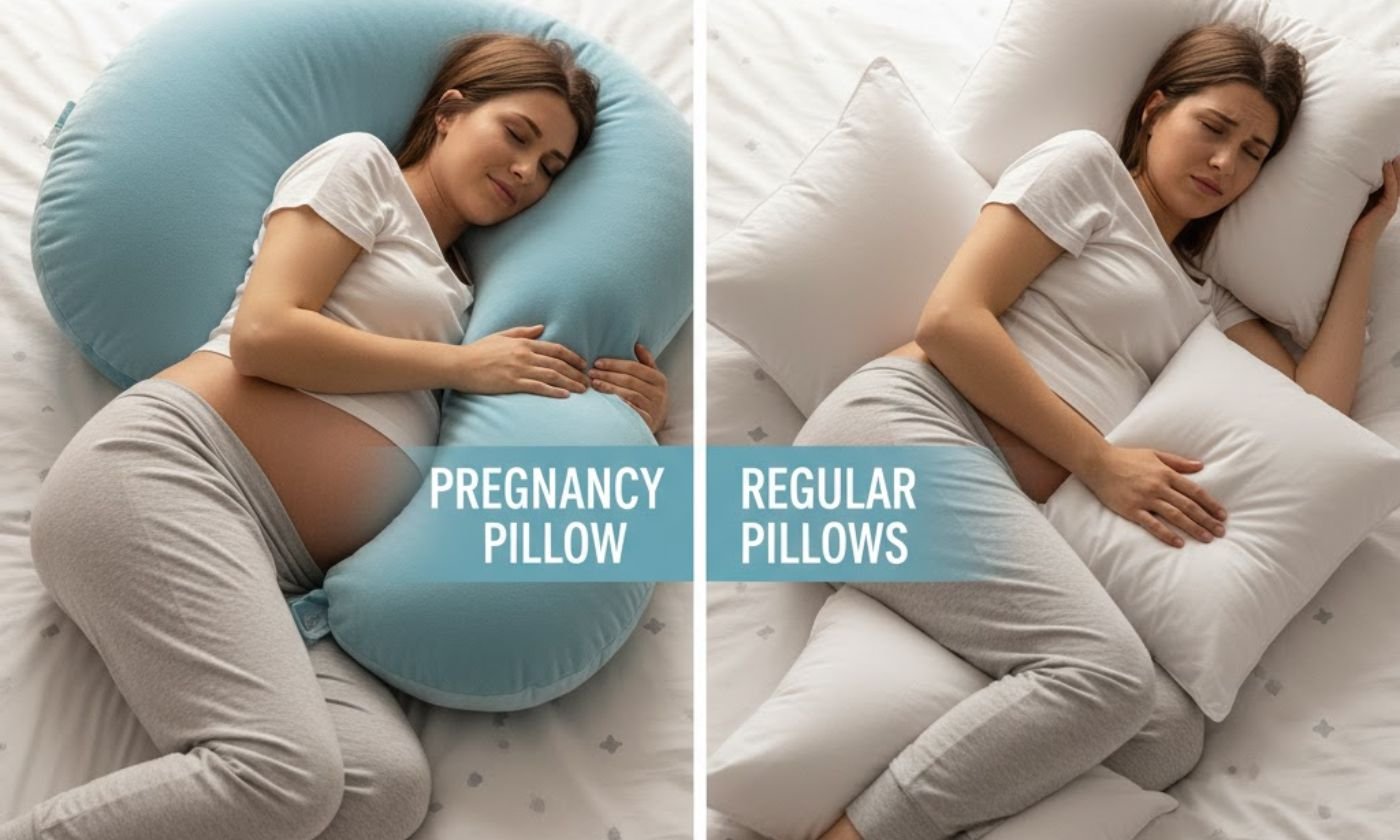
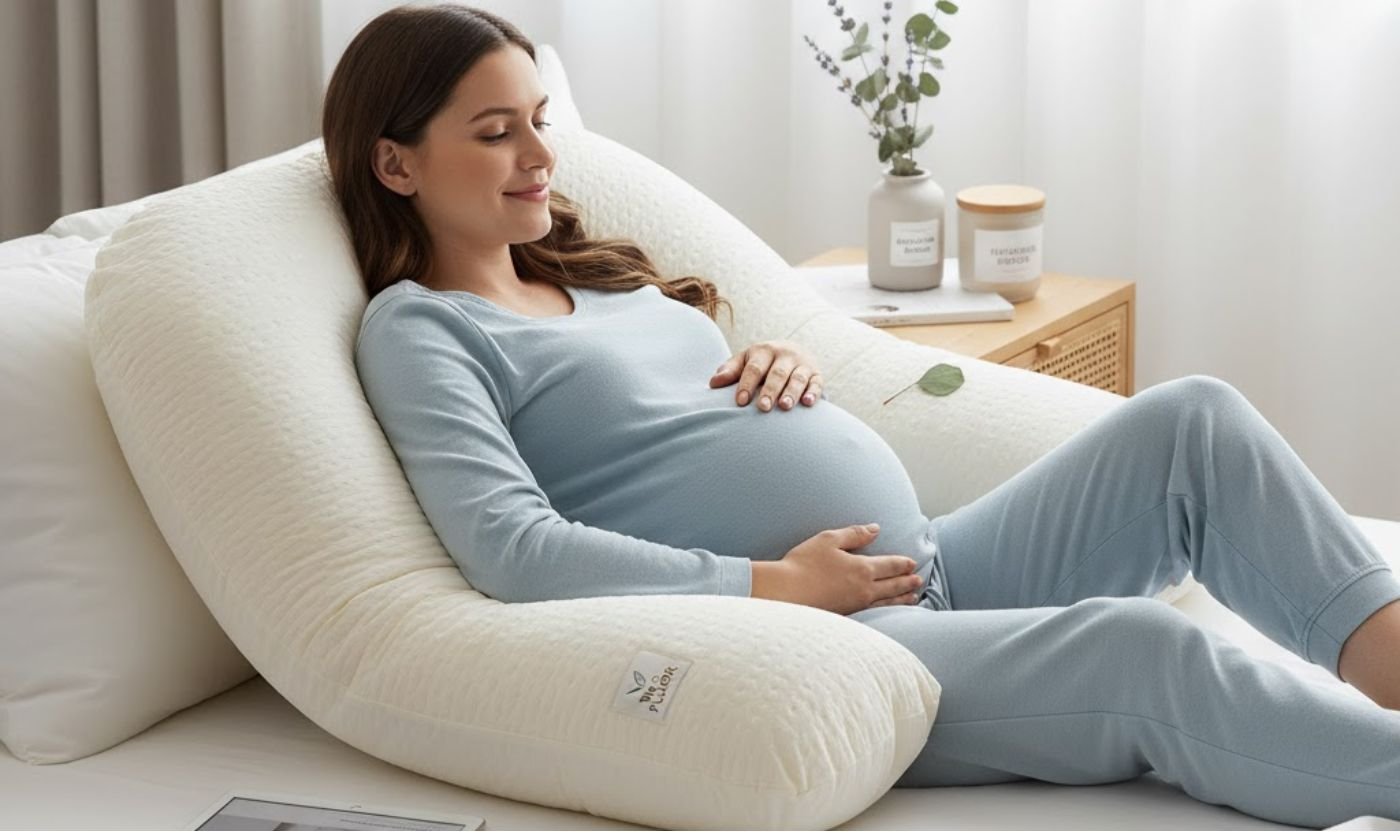
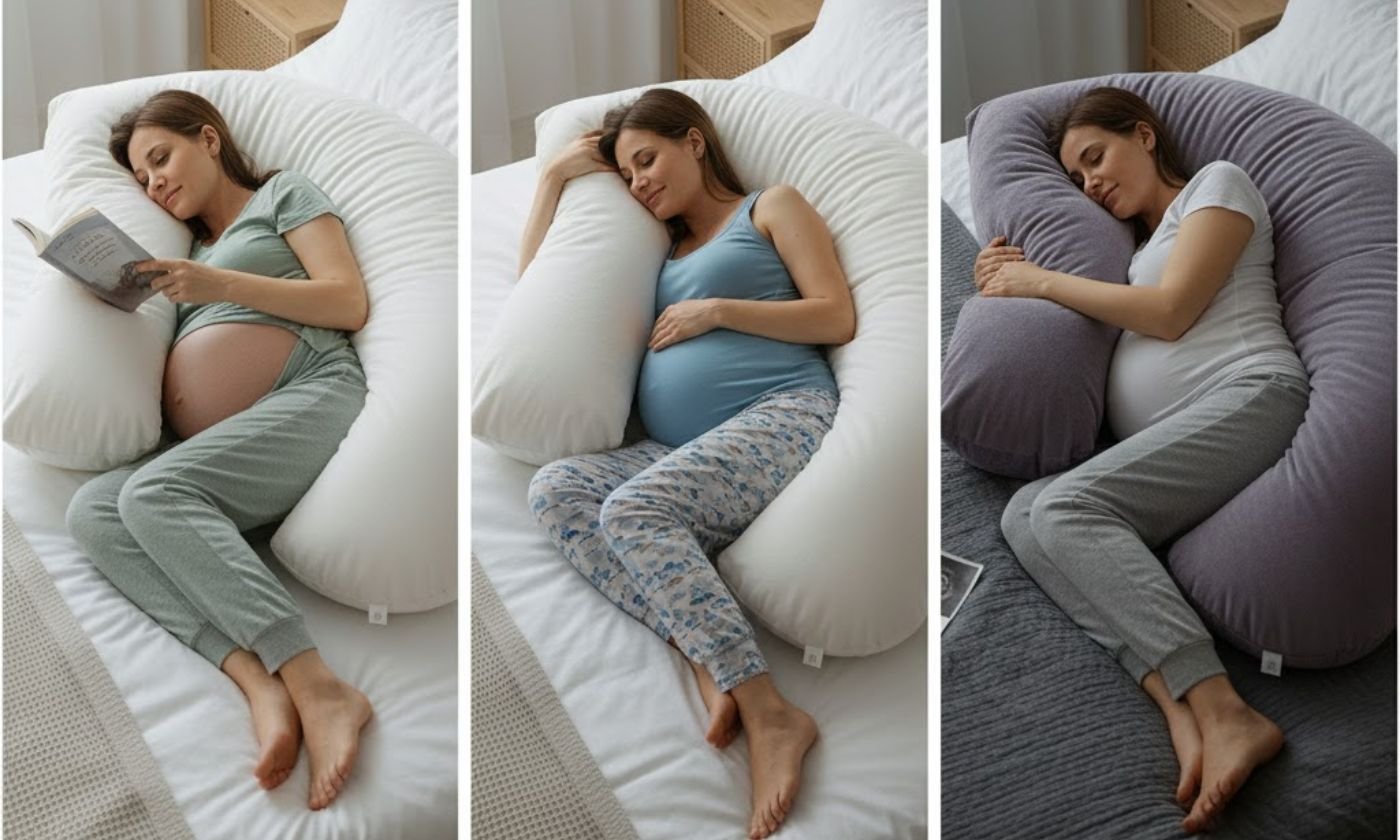
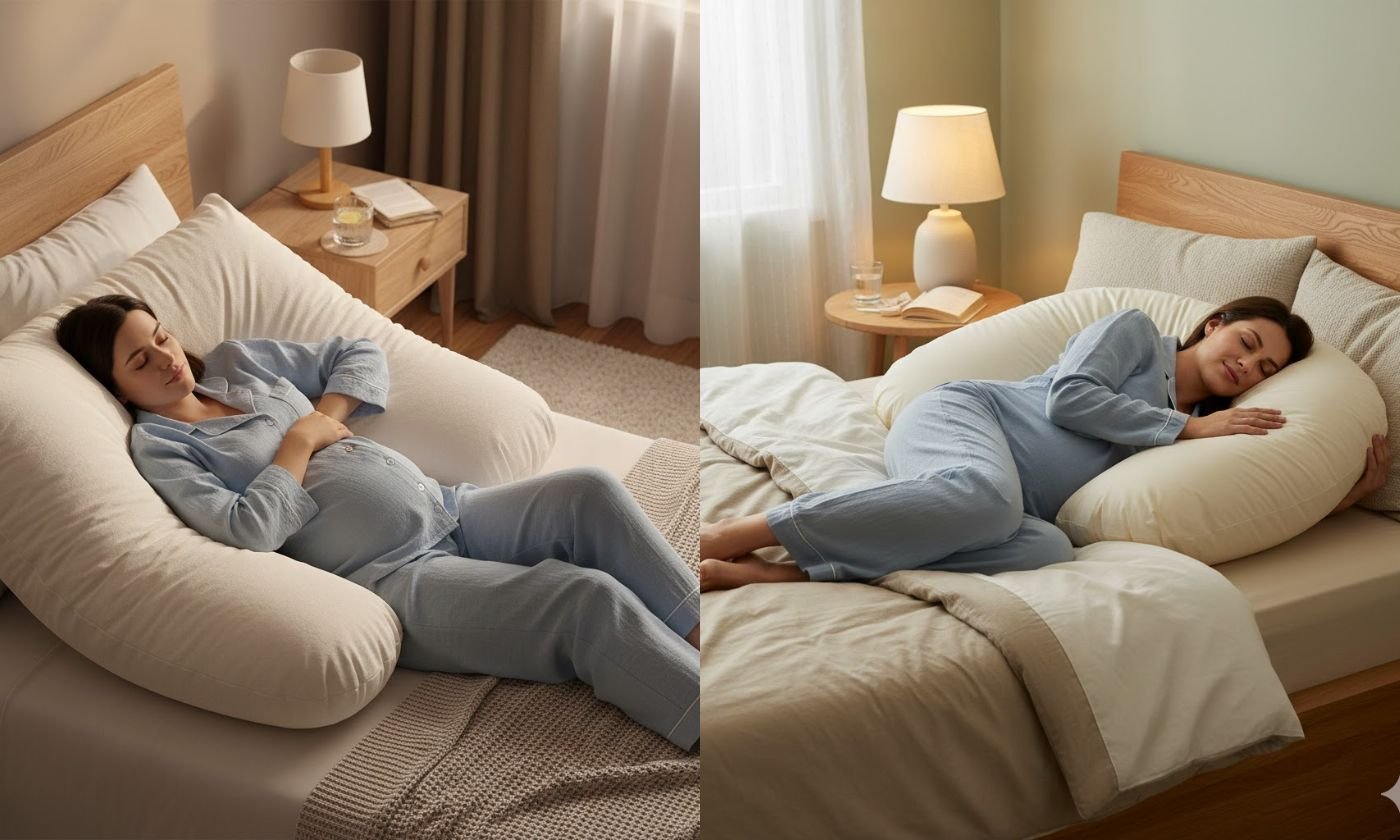
1 Comment